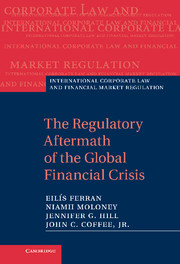Crossref Citations
This Book has been
cited by the following publications. This list is generated based on data provided by Crossref.
Moloney, Kitty
and
Murphy, Gareth
2013.
The spectrum of regulatory engagement.
Law and Financial Markets Review,
Vol. 7,
Issue. 3,
p.
138.
Mügge, Daniel
2013.
THE POLITICAL ECONOMY OF EUROPEANIZED FINANCIAL REGULATION.
Journal of European Public Policy,
Vol. 20,
Issue. 3,
p.
458.
Ferrarini, Guido
and
Saguato, Paolo
2013.
Reforming Securities and Derivatives Trading in the Eu: From Emir to MiFIR.
Journal of Corporate Law Studies,
Vol. 13,
Issue. 2,
p.
319.
Moloney, Niamh
2013.
I. RESETTING THE LOCATION OF REGULATORY AND SUPERVISORY CONTROL OVER EU FINANCIAL MARKETS: LESSONS FROM FIVE YEARS ON.
International and Comparative Law Quarterly,
Vol. 62,
Issue. 4,
p.
955.
Boin, Arjen
Busuioc, Madalina
and
Groenleer, Martijn
2014.
Building European Union capacity to manage transboundary crises: Network or lead‐agency model?.
Regulation & Governance,
Vol. 8,
Issue. 4,
p.
418.
Martinico, Giuseppe
2014.
EU Crisis and Constitutional Mutations: A Review Article.
SSRN Electronic Journal,
Di Noia, Carmine
and
Gargantini, Matteo
2014.
Unleashing the European Securities and Markets Authority: Governance and Accountability After the ECJ Decision on the Short Selling Regulation (Case C-270/12).
European Business Organization Law Review,
Vol. 15,
Issue. 1,
p.
1.
Groenleer, Martijn L. P.
Mijs, Arnout
ten Heuvelhof, Ernst
van Meeuwen, Bert
and
van der Puil, Jessica
2014.
Strategic Behaviour and Crisis-Driven Change in Regulation and Governance of the European Financial and Economic System: From Networks to Hybrids.
SSRN Electronic Journal,
Quaglia, Lucia
2015.
The Politics of ‘Third Country Equivalence’ in Post-Crisis Financial Services Regulation in the European Union.
West European Politics,
Vol. 38,
Issue. 1,
p.
167.
Herlin-Karnell, E.
2015.
Constructing Europe's Area of Freedom, Security, and Justice through the Framework of “Regulation”: A Cascade of Market-Based Challenges in the EU's Fight Against Financial Crime.
German Law Journal,
Vol. 16,
Issue. 1,
p.
49.
Stӑnescu, Cӑtӑlin Gabriel
2015.
Self-Help, Private Debt Collection and the Concomitant Risks.
p.
1.
van Bemmelen van Gent, Ernst
2015.
Criminalization of Market Actor Behavior as Regulatory Tool: The Implementation in the Netherlands of the EU Directive 2014/57 ('Mad II') on Criminal Sanctions for Insider Dealing and Market Manipulation, and its Effects on the Cooperation between the Dutch Public Prosecutors Office (OM) and the Dutch Authority for Financial Markets (AFM).
SSRN Electronic Journal,
Singh, Dalvinder
2015.
The Centralisation of European Financial Regulation and Supervision: Is There a Need for a Single Enforcement Handbook?.
European Business Organization Law Review,
Vol. 16,
Issue. 3,
p.
439.
Spendzharova, Aneta B
2016.
Regulatory cascading: Limitations of policy design in European banking structural reforms.
Policy and Society,
Vol. 35,
Issue. 3,
p.
227.
Haberly, Daniel
and
Wojcik, Dariusz
2016.
Culprits or Bystanders? Offshore Jurisdictions and the Global Financial Crisis.
SSRN Electronic Journal ,
Georgosouli, Andromachi
2016.
R.S.J. Martha, The Financial Obligation in International Law.
Netherlands International Law Review,
Vol. 63,
Issue. 3,
p.
355.
Amorello, Luca
2016.
Ludo Cornelis (ed) (2014) Finance and Law: Twins in Trouble.
European Business Organization Law Review,
Vol. 17,
Issue. 1-2,
p.
195.
Sasso, Lorenzo
2016.
Bank Capital Structure and Financial Innovation: Antagonists or Two Sides of the Same Coin?.
SSRN Electronic Journal,
Spendzharova, Aneta
Versluis, Esther
Radulova, Elissaveta
and
Flöthe, Linda
2016.
Too much, too fast? The sources of banks’ opposition to European banking structural reforms.
Journal of Banking Regulation,
Vol. 17,
Issue. 1-2,
p.
133.
Dorn, Nicholas
2016.
Illegal Entrepreneurship, Organized Crime and Social Control.
Vol. 14,
Issue. ,
p.
311.





